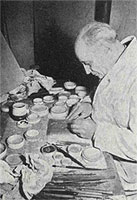
 Jean Serrière was born on February 26, 1893, in Nancy. In 1900, he came to Paris for his studies but chose not to enter the School of Fine Arts as its teachings did not align with his interests. Instead, he started painting at the Palette, an independent studio on Rue du Val-de-Grâce, where artists such as J.-E. Blanche, Desvallières, Cottet, and Laprade taught. Later, he attended the Lejeune Academy in Montparnasse, where he met Guindet, Gromaire, Dubreuil, and also collaborated with the decorator Karbowsky.
Jean Serrière was born on February 26, 1893, in Nancy. In 1900, he came to Paris for his studies but chose not to enter the School of Fine Arts as its teachings did not align with his interests. Instead, he started painting at the Palette, an independent studio on Rue du Val-de-Grâce, where artists such as J.-E. Blanche, Desvallières, Cottet, and Laprade taught. Later, he attended the Lejeune Academy in Montparnasse, where he met Guindet, Gromaire, Dubreuil, and also collaborated with the decorator Karbowsky.
After the war of 1914, Jean Serrière became interested in hammered copper and silver dinanderie. Around 1922, he started creating furniture, which he exhibited at the Pavillon de Marsan. His insatiable curiosity and perhaps the influence of his contact with metal led him to study enamels. He initiated himself in the technique by reading specialized books and built his first coke-fired furnace while living in the countryside. His career as an enamelist began.
From 1921, he exhibited at the Salon des Artistes Décorateurs, showcasing dinanderie and later his early enamel works, while still maintaining a presence at the Salon d'Automne as a painter. In 1922, he received a travel scholarship. He earned prizes and diplomas at the expositions of 1925 and 1937. From 1920 to 1933, he participated in permanent exhibitions at Hébrard's alongside Metthey, Marinot, Degas, Bourdelle, Pompon, and others. His works can be found in numerous private collections and museums in France and abroad. Jean Serrière was appointed Knight of the Legion of Honor in 1938.
Though known as a master of contemporary enameling, it's essential to recognize the diversity of his talents. While remaining a painter at heart, his personality has significantly influenced furniture, especially dinanderie. He did not receive any specialized training in enamel. Instead, a series of research and experiments revealed to him the secrets of this precise and rigorous craft.
From the moment he dedicated himself to enamel, he conceived his works based on the chosen material as his new mode of expression. Although landscapes are rarely his subject, he composes scenes inspired by antiquity and fairy tales, featuring figures reminiscent of Monticelli. He excels in creating admirable still life paintings where "objects" are reduced to profound and sensitive harmonies of color. As an observant and amused observer of animals, Serrière adopts the cloisonné technique to preserve their linear purity in his ducks, birds, or gazelles, sometimes reminiscent of Pisanello's precision.
As a colorist and skilled technician, Jean Serrière often allows the reddish tones of the copper plate to appear, which the "fondant" softens into amber roses. He skillfully plays with the art of opacity and transparency using colored glass powder with metallic oxides. The heat of the furnace, through six or seven brief firings, melts, mixes, and transposes the powder, giving birth to the mysterious and enduring beauty of the enameled plate.
Jean Serrière passed away on December 20, 1968, in the 14th arrondissement of Paris at the age of 75. (Information provided by V.TIFFAGOM on our forum).
Sources : Mobilier et Decoration N°5 Juin 1954